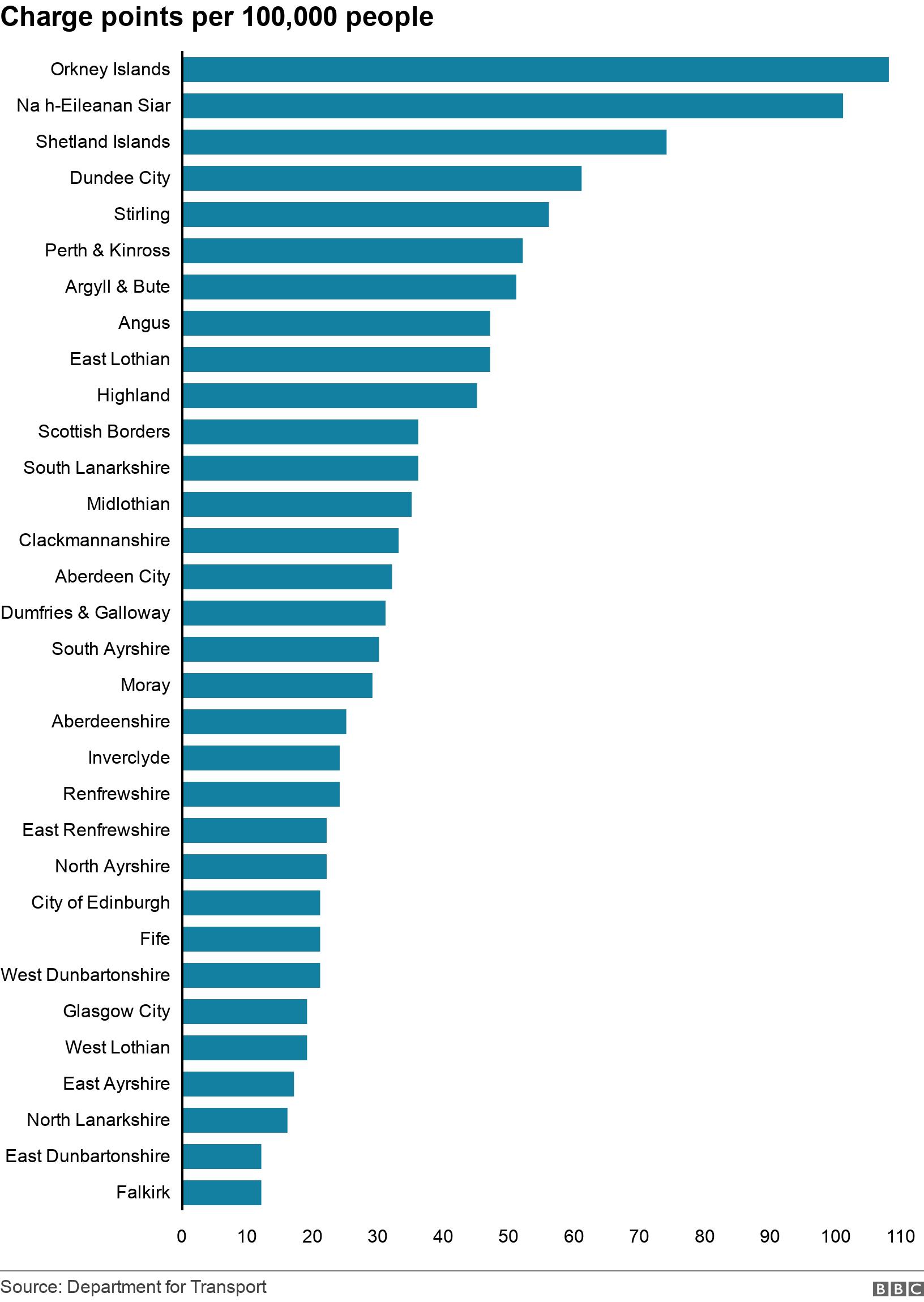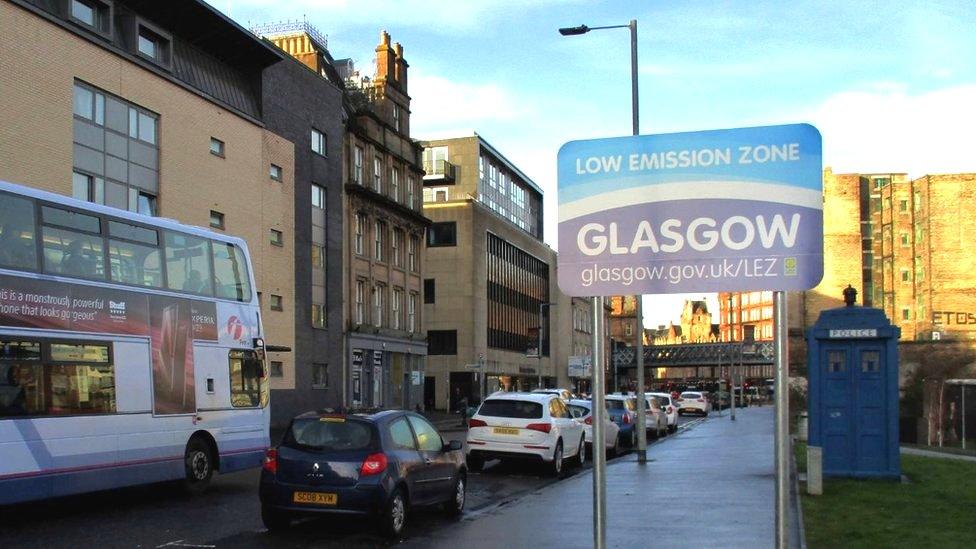Enough renewables to meet 90% Scottish electricity demand
- Published

Beatrice Offshore Wind Farm is currently Scotland's single largest source of renewable energy
Scotland generated enough electricity from renewable sources last year to meet the equivalent of 90.1% of its total electricity consumption, according to latest figures.
The Scottish government data for 2019 showed an increase of 13.4% on 2018 - meaning the country generated 30.5 TWh of electricity from renewable sources.
That's enough to charge almost 6.7bn mobile phones for a year, or boil about 700bn kettles.
The target is for 100% of the country's electricity to be generated from renewable sources by the end of 2020.
And good progress is being made - in 2009, it was only 27.2%.
But we won't know whether Scotland has met this target or not until more data is published next year.
Although electricity only makes up part of the mix of the energy Scotland needs, the amount of energy produced in Scotland from renewable resources increased between 2017 and 2018 to 21.1%.
The Scottish government said to decarbonise energy-intensive industries, heating buildings and transport, renewable electricity supplies would need to be further enhanced.
Scotland's renewable energy targets

By 2030, Scottish ministers want renewable energy generation to account for 50%, external of energy demand across electricity, heat and transport.
In order to achieve the target, Scotland has been moving away from burning fossil fuels, with the last coal-fired power station, Longannet, closing in 2016. The only remaining gas-fired power station is at Peterhead in Aberdeenshire.
Onshore wind delivers about 70% of capacity, followed by hydro and offshore wind as Scotland's main sources of renewable power.
Scotland's largest single source is the Beatrice offshore wind farm. Its 84 turbines - each with three 75m (246ft) blades - went into operation last year. The wind farm is is capable of generating enough power for 450,000 homes., external
The Seagreen Wind Farm, under construction off Angus, will eventually be even bigger and able to power 1.3m homes, external.
Scotland's emissions targets
What is climate change?
While the pandemic has led to a temporary dip in greenhouse gas emissions, there is still requirement for fundamental changes in the way we live our lives in order to achieve net zero.
Net zero means any emissions will be balanced out by schemes to offset an equivalent amount of greenhouse gases from the atmosphere - such as planting trees, or using technology to capture carbon and store it.
So what are Scotland's climate change targets, and are they the most ambitious in the world as has been claimed, external?
The Scottish government has set itself a legally-binding target to cut greenhouse gas emissions to net zero by 2045, five years ahead of the date set for the UK as a whole., external
The Scottish government says its targets are "the toughest anywhere in the world".
They are certainly among the most ambitious.
However, other countries - such as Sweden, external - have passed legislation with the same goal. Sweden did so two years before Scotland, and it has also set milestones along the way. But Scotland's milestone targets are more ambitious and include emissions from aviation and shipping.
They also don't rely on international credits, which is where countries can pay for emissions to be reduced, external elsewhere instead of reducing their own.
How is Scotland doing?

Much progress has been made, but the hardest changes are still to come.
Emissions of greenhouse gases - such as carbon dioxide - have been cut to about half of what they were 30 years ago, external.
However, experts say, external much of this progress has been accomplished by picking off the "low hanging fruit" - the most cost effective or publicly-acceptable changes to make.
The areas that need tackling are transport (about a third of all emissions), farming and land use (about a quarter), business and heavy industry (about a fifth) and how we heat our homes.
Tricky decisions will have to be made, especially with so much of Scotland's economy based around the oil and gas industry.

A Scottish government-appointed commission is grappling with the question of how to protect the economy and ensure a "just transition" so oil workers and farmers don't lose out as the world moves away from fossil fuels.
The commission has already published some advice to the Scottish government on how to make recovery from the pandemic greener.
It says immediate actions that can be taken, external include investing in warmer homes, supporting bus travel, and attaching green conditions to funding.
Transport
Electric vehicles account for more than 2% of all cars and vans on the road in Orkney
Transport accounts for about a third of Scotland's greenhouse gas emissions and some steps have been taken to reduce this but the overwhelming majority of vehicles on the road are still greenhouse gas-emitting petrol or diesel engines.
The Scottish government has said, external it wants to have "phased out" the need for new petrol and diesel cars by 2030 - and hopes to reduce the use of cars generally, with the number of kilometres driven to be reduced by 20%.
There are now more than 1,500 publicly-available charge points in Scotland for electric vehicles and the number of new EV and hybrid cars registered in the UK was up nearly 40% on the same period last year.
But for many drivers an EV is prohibitively expensive and concerns over the range the cars can currently offer is a concern for some potential owners.
Their popularity is expected to increase significantly as the technology gets better but this will see demand for electricity generation rise too.
The UK government's Department for Transport says, external Scotland now has more than 1,500 charging devices, and across the UK there are now more charging locations than petrol stations.

Of course, this year has seen some huge changes to everyone's lives. During lockdown, the whole country was asked to stay at home unless leaving was essential.
In Scotland, everyone who can work from home was asked to keep doing so.
That has had a big impact on how often we travel, how far, and how we get to places - and as the number of Covid cases has risen, travel has dropped again.
At the beginning of this month, compared with the same time last year,, external train travel was down by 85%, air by 75%, concessionary bus travel by 60%, and ferry journeys by 55%.
Despite the public being advised to avoid public transport where possible and not to car share, car journeys were still down by 25%.

But the pandemic doesn't mean planning for a greener future has stopped.
Low emission zones, external that will see polluting vehicles banned from entering city centres (and receive a penalty notice if they don't comply) are planned for Aberdeen, Edinburgh and Dundee but so far only Glasgow has introduced measures which only apply to 60% of buses that enter the zone.
Because of the pandemic, implementing the low emission zones was paused over the summer, external, but officials have vowed to see the changes through "at the earliest possible time".
In a bid to discourage commuters from taking their cars to work, the Scottish government brought in the Workplace Parking Levy.
It allows councils to tax businesses on staff parking spaces but, so far, no councils have committed to introducing the levy this year.
As well as cutting road transport emissions, the government needs to find a way to stop the growth in emissions from air travel.
Since 1990, emissions from international aviation from Scotland have increased by 181% and the latest data, from 2018, external, showed they were still increasing.
The overall statistics have not been released yet to show the impact lockdown had on aviation emissions. But, according to the Global Carbon Project, the mass grounding of flights during the peak of the pandemic saw CO2 emissions from aviation reduced by up to 60%.
The Scottish government has also scrapped plans to cut the amount of tax paid by passengers flying from Scottish airports after facing a backlash over the environmental impact.
Electric-powered planes could be a solution to aviation emissions, but they are still at an early stage.
Plans for the shortest scheduled flight in the world - the 1.7 mile jump between the Orkney islands of Westray and Papa Westray - to use an electric-powered plane could happen soon.
Farming methods

The UN says high consumption of meat and dairy produce is fuelling global warming, and researchers based in Scotland have been investigating ways of reducing the environmental impact of farming.
For example, one group of scientists has found a way of reducing the methane produced by cattle, external.
Heating homes

About 15% of Scotland's emissions come from domestic housing, with most homes (about 80%) still relying on gas central heating systems.
Ministers have set a target, external of having 50% of all new heating systems being installed to be zero-emissions models by 2025.
Instead of gas, heating systems should use renewable energy, or rely on low-carbon alternatives such as heat pumps.
And 20,000 households have benefited, external from better insulation and new, more efficient - although still often gas - heating systems, funded by the Scottish government.
Planting trees

Trees are still the most effective way of absorbing CO2 from the atmosphere.
To meet targets, the UK needs a net increase of 32,000 hectares of woodland, external planted every year for the next 30 years - equating to about 1.5bn trees.
Figures claim most of the trees planted in the UK were planted in Scotland - 11,000 of the 13,700 hectares planted in 2019-20, external.
By 2024, the Scottish government aims, external to be creating 18,000 hectares of new woodlands per year, with the ultimate goal of having 21% of Scotland's land covered by forest by 2032 - compared to 19% today.
But there's more to it than just planting trees - it's important that the right trees are planted in the right places, taking into consideration factors such as soil type, water levels, temperatures and the surrounding landscape and tree species.



Use the tool below and we could be in touch.
If you are reading this page on the BBC News app, you will need to visit the mobile version of the BBC website to submit your question on this topic.
Related topics
- Wind power
- Greenhouse gas emissions
- Scottish government
- Scotland
- Edinburgh
- Scotland economy
- Sweden
- Orkney
- Greenhouse gas monitoring
- Intergovernmental Panel on Climate Change
- Energy industry
- Agriculture
- Transport
- COP26
- Scottish Power
- Electric cars
- United Nations
- Climate
- Oil
- Environment
- Renewable energy in the UK
- Wind farms
- Glasgow
- Air travel
- Renewable energy
- Peterhead
- Car industry
- Dundee
- Published2 November 2020

- Published30 January 2020

